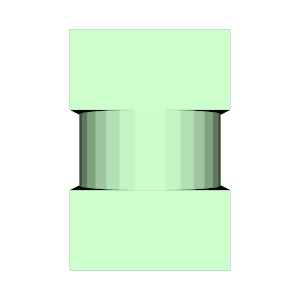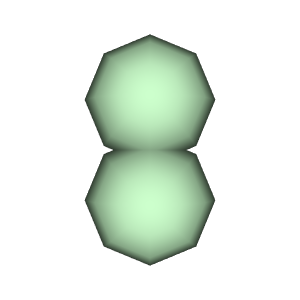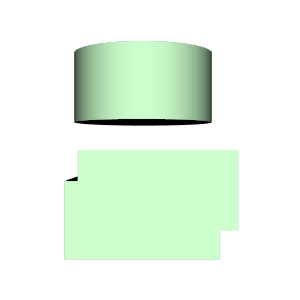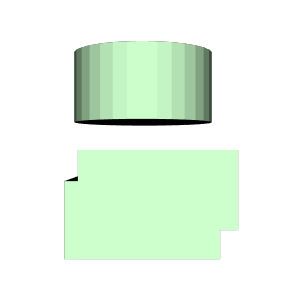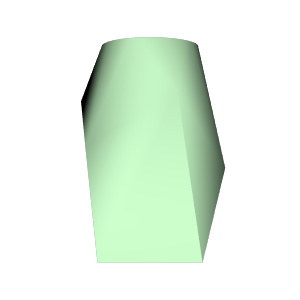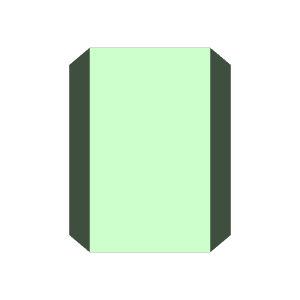This repository shows how to use VTK, vtkbool, and Walnut to make STL files in C++ for 3d printing.
VTK library was created on 1993. As such, its API does not use new C++ features (such as std::function or std::shared_ptr)
where they would be helpful. All of the objects are internally reference counted. The reference count can be managed by
wrapping the type up in a vtkSmartPointer, such as vtkSmartPointer<vtkAlgorithm>.
VTK stands for "The Visualization Toolkit". It is able to process and visualize 3d meshes, but the library also deals with plots, images, cameras, widgets, etc... There is a decent amount of documentation for VTK, but the documentation tends to focus on the all aspects of VTK except for 3d mesh processing. I have found the doxygen pages to be most useful for the 3d mesh functions. For these examples, all of the rendering boilerplate has been moved to render.h.
VTK has a BSD 3 clause license, vtkbool is licensed Apache 2.0, and Walnut is MIT licensed.
Other missing CAD features:
- Minkowski sum
- 3d to 2d projection
- Rounded corner option for shapes
First install the VTK development libraries and CMake. Make sure that you cloned vtk_print_examples recursively by checking that the vtkbool directory is non-empty. Build the examples with these commands:
mkdir build
cd build
cmake ..
make -j4
Typically in VTK all of the meshes (cubes, spheres, etc) would have its own actor which renders it to the output window. However, to generate an STL file, all of those meshes need to be merged together. With the CSG model, one would use a union to do so. I have been unable to get the boolean filter (union/intersection) that is built into VTK to work with anything other than their sphere example. I suspect that's what the authors means when they say it does not work with "co-planar surfaces". The vtkbool library is basically a drop in boolean filter replacement.
This example shows 2 cubes and a cylinder connected together with a union. The colors are an artifact of the last vtkbool union that is applied.
This shows the one example I can get of the native VTK union working. It unions 2 spheres together.
One problem with vtkbool is that the input objects must intersect. If one tries to union two disjoint meshes together, vtkbool will print an error to stderr and return an empty mesh. As a workaround, 3d meshes can be "appended". The output will be completely correct if the inputs were disjoint. Even if the inputs intersect, appending them still produces something cura can print, even if the intersection is technically covered twice.
This example uses append for 2 cubes that intersect and a cylinder that's not connected.
This is the same example as append_for_union, except that it uses Walnut, which does support disjoint meshes. Even though the png is identical to append_for_union, the STL file has the redundant faces removed, unlike append_for_union.
vtkTransformFilter can do rotations, scaling, and translations. This example shows it doing a rotation and translation.
The vtkDelaunay3D computes a mostly accurate 3d convex hull. However, it outputs unstructured data (a collection of
tetrahedons), which has to be converted back into a 3d mesh with tkDataSetSurfaceFilter.
The SetOffset option is important. If it is set too low, the outputed 3d "convex" hull won't be complete convex.
Setting it higher creates more warning spam on the console.
This example shows a linear extrusion of a pentagon.
This example shows a pentagon that is extruded linearly and rotated at the same time. That forms a spring shape.
vtkParametricFunctionSource can generate a 3d mesh by evaluating a parameteric function with a specified resolution.
This example uses the built in torus function.
VTK is designed to have scalar data associated with each vertex or cell. The
mapper converts the scalar data into colors for the mesh faces. This example
uses the vtkApplyColors option to directly set the cell scalar to the color
(instead of making the mapper use a lookup table from integer to
color).
This example also shows how helper functions can be written to help with creating CSGs.
